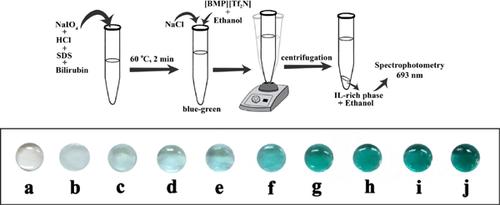Current Analytical Chemistry ( IF 1.8 ) Pub Date : 2020-07-31 , DOI: 10.2174/1573411015666190212123437 Asiye A. Avan 1 , Hayati Filik 1

|
Background: An Ionic Liquid-based based Dispersive Liquid-Liquid Microextraction (IL-DLLME) method was not applied to preconcentration and determination of bilirubin. Ionic Liquids (ILs) are new chemical compounds. In recent years, Ionic Liquids (ILs) have been employed as alternative solvents to toxic organic solvents. Due to these perfect properties, ILs have already been applied in many analytical extraction processes, presenting high extraction yield and selectivity for analytes.
Methods: In this study, IL-DLLME was applied to biological samples (urine and serum) for the spectrophotometric detection of bilirubin. For bilirubin analysis, the full-color development was based on the reaction with periodate in the presence of hydrochloric acid. The high affinity of bilirubin for the ionic liquid phase gave extraction percentages above 98% in 0.3 M HCl solution.
Results: Several IL-extraction parameters were optimized and room temperature ionic liquid 1-butyl- 1-methylpyrrolidinium bis(trifluoromethylsulfonyl)imide and ethanol were used as extraction and disperser solution. The linear range was found in the range of 0.5-6.0 μM (0.3-3.5 μg mL-1) and the limits of detection of the proposed method was 0.5 μM (0.3 μg mL-1). The proposed method was applied for the preconcentration and separation of trace bilirubin in real urine samples. Also, the recoveries for bilirubin in spiked biological samples (urine and serum) were found to be acceptable, between 95-102%.
Conclusion: The proposed IL-DLLMEapproach was employed for the enrichment and determination of trace levels of bilirubin in urine samples using NaIO4 as an oxidizing agent and Uv-vis spectrophotometric detection. The periodate oxidation of bilirubin is rapid, effective, selective, and simple to perform. The method contains only HCl, NaOI4, and an anionic surfactant. The method may be useful for economizing in the consumption of reagents in bilirubin determining. The IL-DLLMEmethod ensures a high yield and has a low toxicity no skin sensitization, no mutagenicity and no ecotoxicity in an aquatic environment since only very low quantities of an IL is required. For full-color formation, no any extra auxiliary reagents are required. Besides, the IL-DLLME technique uses a low-cost instrument such as Uv-vis which is present in most of the medical laboratories.
中文翻译:

离子液体和光度法测定生物样品中胆红素的分散液微萃取
背景:基于离子液体的分散液-液微萃取(IL-DLLME)方法未用于胆红素的预浓缩和测定。离子液体(ILs)是新的化合物。近年来,离子液体(ILs)已被用作有毒有机溶剂的替代溶剂。由于这些完美的特性,离子色谱已经在许多分析提取过程中得到应用,具有很高的提取产率和对分析物的选择性。
方法:本研究将IL-DLLME用于生物样品(尿液和血清)中,以分光光度法检测胆红素。对于胆红素分析,全色显影是基于在盐酸存在下与高碘酸盐的反应。胆红素对离子液相的高亲和力使提取液在0.3 M HCl溶液中的提取率超过98%。
结果:优化了几种IL提取参数,室温离子液体1-丁基-1-甲基吡咯烷鎓双(三氟甲基磺酰基)亚胺和乙醇用作提取和分散溶液。线性范围为0.5-6.0μM(0.3-3.5μgmL-1),建议的检测限为0.5μM(0.3μgmL-1)。该方法用于实际尿样中痕量胆红素的富集和分离。此外,发现加标的生物样品(尿液和血清)中胆红素的回收率在95-102%之间是可以接受的。
结论:拟议的IL-DLLME方法用于以NaIO4为氧化剂和Uv-vis分光光度法检测尿样中的胆红素,并对其进行富集和测定。胆红素的高碘酸盐氧化反应快速,有效,选择性好并且易于实施。该方法仅包含HCl,NaOI4和阴离子表面活性剂。该方法可用于节省胆红素测定中试剂的消耗。IL-DLLME方法可确保高产量,并且毒性低,在水生环境中不会引起皮肤过敏,致突变性和生态毒性,因为只需要非常少量的IL。为了形成全彩色,不需要任何额外的辅助试剂。除了,


























 京公网安备 11010802027423号
京公网安备 11010802027423号